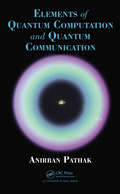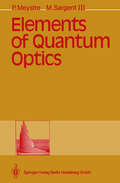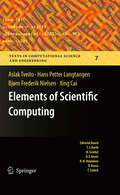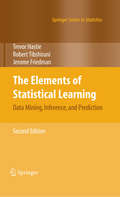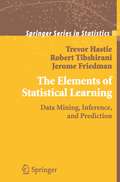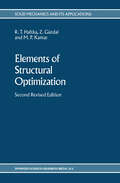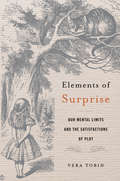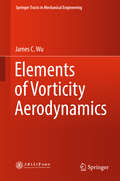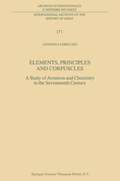- Table View
- List View
Elements of Quantum Computation and Quantum Communication
by Anirban PathakWhile there are many available textbooks on quantum information theory, most are either too technical for beginners or not complete enough. Filling this gap, Elements of Quantum Computation and Quantum Communication gives a clear, self-contained introduction to quantum computation and communication. Written primarily for undergraduate students in p
Elements of Quantum Information
by Wolfgang P. Schleich Herbert Walther'Elements of Quantum Information' introduces the reader to the fascinating field of quantum information processing, which lives on the interface between computer science, physics, mathematics, and engineering. This interdisciplinary branch of science thrives on the use of quantum mechanics as a resource for high potential modern applications. With its wide coverage of experiments, applications, and specialized topics - all written by renowned experts - 'Elements of Quantum Information' provides an indispensable up-to-date account of the state of the art of this rapidly advancing field and takes the reader straight up to the frontiers of current research. The articles have first appeared as a special issue of the journal 'Fortschritte der Physik/Progress of Physics'. Since then, they have been carefully updated. The book will be an inspiring source of information and insight for anyone researching and specializing in experiments and theory of quantum information.
Elements of Quantum Optics
by Pierre Meystre Murray Sargent IIIThis book grew out of a 2-semester graduate course in laser physics and quantum optics. It requires a solid understanding of elementary electro magnetism as well as at least one, but preferably two, semesters of quan tum mechanics. Its present form resulted from many years of teaching and research at the Max-Planck-Institut fi. ir Quantenoptik, the University of Munich, and the University of Arizona. The contents have evolved signi ficantly over the years, due to the fact that quantum optics is a rapidly changing field. Because the amount of material that can be covered in two semesters is finite, a number of topics had to be left out or shortened when new material was added. Important omissions include the manipulation of atomic trajectories by light, superradiance, and descriptions of experiments. Rather than treating any given topic in great depth, this book aims to give a broad coverage of the basic elements that we consider necessary to carry out research in quantum optics. We have attempted to present a var iety of theoretical tools, so that after completion of the course students should be able to understand specialized research literature and to produce original research of their own. In doing so, we have always sacrificed rigor to physical insight and have used the concept of "simplest nontrivial example" to illustrate techniques or results that can be generalized to more complicated situations.
Elements of Quantum Optics
by Pierre Meystre Murray SargentFrom the reviews: "This is a book that should be found in any physics library. It is extremely useful for all graduate students, Ph.D. students and researchers interested in the quantum physics of light." Optics & Photonics News
Elements of Quantum Optics
by Pierre Meystre Murray SargentWith a new chapter on quantum entanglement and quantum information, as well as added discussions of the quantum beam splitter, electromagnetically induced transparency, slow light and the input-output formalism, this fourth edition of the brilliant work on quantum optics has been much updated. It still gives a self-contained and broad coverage of the basic elements necessary to understand and carry out research in laser physics and quantum optics, including a review of basic quantum mechanics and pedagogical introductions to system-reservoir interactions and to second quantization. The text reveals the close connection between many seemingly unrelated topics, such as probe absorption, four-wave mixing, optical instabilities, resonance fluorescence and squeezing.
Elements of Quantum Optics
by Pierre Meystre Murray, III SargentThis book grew out of a 2-semester graduate course in laser physics and quantum optics. It requires a solid understanding of elementary electro magnetism as well as at least one, but preferably two, semesters of quantum mechanics. Its present form resulted from many years of teaching and research at the University of Arizona, the Max-Planck-Institut fiir Quanten optik, and the University of Munich. The contents have evolved signifi cantly over the years, due to the fact that quantum optics is a rapidly chang ing field. Because the amount of material that can be covered in two semes ters is finite, a number of topics had to be left out or shortened when new material was added. Important omissions include the manipulation of atomic trajectories by light, superradiance, and descriptions of experiments. Rather than treating any given topic in great depth, this book aims to give a broad coverage of the basic elements that we consider necessary to carry out research in quantum optics. We have attempted to present a vari ety of theoretical tools, so that after completion of the course students should be able to understand specialized research literature and to produce original research of their own. In doing so, we have always sacrificed rigor to physical insight and have used the concept of "simplest nontrivial exam ple" to illustrate techniques or results that can be generalized to more com plicated situations.
Elements of Radio Frequency Energy Harvesting and Wireless Power Transfer Systems
by Taimoor Khan Nasimuddin Yahia M.M. AntarThis book focuses on elementary concepts of both radio frequency energy harvesting (RFEH) and wireless power transfer (WPT), and highlights their fundamental requirements followed by recent advancements. It provides a systematic overview of the key components required for RFEH and WPT applications and also comprehensively introduces the pioneering research advancements achieved to date. The state-of-the-art circuit design topologies for the two different applications are presented mainly in terms of antenna operating frequencies, polarization characteristics, efficient matching network circuits, rectifier topologies, and overall rectenna systems. The book serves as a single point of reference for practicing engineers and researchers searching for potential sources and elements involved in the RFEH system as well as in the WPT system, and need rapid training and design guidelines in the following areas: • Different sensing elements used in RFEH and WPT • Inclusions of mathematical expressions and design problems • Illustration of some design examples and performance enhancement techniques
Elements of Radio Frequency Energy Harvesting and Wireless Power Transfer Systems
by Taimoor Khan Nasimuddin Yahia M.M. AntarThis book focuses on elementary concepts of both radio frequency energy harvesting (RFEH) and wireless power transfer (WPT), and highlights their fundamental requirements followed by recent advancements. It provides a systematic overview of the key components required for RFEH and WPT applications and also comprehensively introduces the pioneering research advancements achieved to date. The state-of-the-art circuit design topologies for the two different applications are presented mainly in terms of antenna operating frequencies, polarization characteristics, efficient matching network circuits, rectifier topologies, and overall rectenna systems. The book serves as a single point of reference for practicing engineers and researchers searching for potential sources and elements involved in the RFEH system as well as in the WPT system, and need rapid training and design guidelines in the following areas: • Different sensing elements used in RFEH and WPT • Inclusions of mathematical expressions and design problems • Illustration of some design examples and performance enhancement techniques
Elements of Rapid Solidification: Fundamentals and Applications (Springer Series in Materials Science #29)
by Monde A. OtooniElements of Rapid Solidification: Fundamentals and Applications is the product of many years of concentrated work in the field of rapid solidification and processing. This quasi-monograph is unique in two ways. It brings together the talent of many international scientists in an effort to focus attention on all aspects of a new scientific field and it concentrates on fundamentals and practical applications. Simply stated, this book has been written by the senior students in the field of rapid solidification technology for the new generation of solid-state physicists, materials scientists, materials engineers, metallurgists and ceramicists.
The Elements of Relativity
by David M. WittmanRelativity has much to offer for a well-rounded education. Yet books on relativity either assume a strong background in physics and math, aimed at advanced physics students, or, alternatively, offer a broad description with little intellectual challenge. This book bridges the gap. It aims at readers with essentially no physics or math background, who still find it rewarding to think rigorously. The book takes a "thinking tools" approach, by first making readers comfortable with a new thinking tool and then applying it to learn more about how nature works. By the end of the book, readers will have collected a versatile toolbox and will be comfortable using the tools to think about and really understand the intriguing phenomena they may have only heard about, including the twin paradox, black holes, and time travel. End-of-chapter exercises span a range of difficulty, allowing adventurous readers to stretch their understanding further as desired. Students who have studied, or are studying, relativity at a more mathematical level will also find the book useful for a more conceptual understanding.
Elements of Scientific Computing (Texts in Computational Science and Engineering #7)
by Aslak Tveito Hans Petter Langtangen Bjørn Frederik Nielsen Xing CaiScience used to be experiments and theory, now it is experiments, theory and computations. The computational approach to understanding nature and technology is currently flowering in many fields such as physics, geophysics, astrophysics, chemistry, biology, and most engineering disciplines. This book is a gentle introduction to such computational methods where the techniques are explained through examples. It is our goal to teach principles and ideas that carry over from field to field. You will learn basic methods and how to implement them. In order to gain the most from this text, you will need prior knowledge of calculus, basic linear algebra and elementary programming.
The Elements of Statistical Learning: Data Mining, Inference, and Prediction, Second Edition (Springer Series in Statistics)
by Trevor Hastie Robert Tibshirani Jerome FriedmanThis book describes the important ideas in a variety of fields such as medicine, biology, finance, and marketing in a common conceptual framework. While the approach is statistical, the emphasis is on concepts rather than mathematics. Many examples are given, with a liberal use of colour graphics. It is a valuable resource for statisticians and anyone interested in data mining in science or industry. The book's coverage is broad, from supervised learning (prediction) to unsupervised learning. The many topics include neural networks, support vector machines, classification trees and boosting---the first comprehensive treatment of this topic in any book. This major new edition features many topics not covered in the original, including graphical models, random forests, ensemble methods, least angle regression & path algorithms for the lasso, non-negative matrix factorisation, and spectral clustering. There is also a chapter on methods for "wide'' data (p bigger than n), including multiple testing and false discovery rates.
The Elements of Statistical Learning: Data Mining, Inference, and Prediction (Springer Series in Statistics)
by Trevor Hastie Robert Tibshirani Jerome FriedmanDuring the past decade there has been an explosion in computation and information technology. With it have come vast amounts of data in a variety of fields such as medicine, biology, finance, and marketing. The challenge of understanding these data has led to the development of new tools in the field of statistics, and spawned new areas such as data mining, machine learning, and bioinformatics. Many of these tools have common underpinnings but are often expressed with different terminology. This book describes the important ideas in these areas in a common conceptual framework. While the approach is statistical, the emphasis is on concepts rather than mathematics. Many examples are given, with a liberal use of color graphics. It should be a valuable resource for statisticians and anyone interested in data mining in science or industry. The book’s coverage is broad, from supervised learning (prediction) to unsupervised learning. The many topics include neural networks, support vector machines, classification trees and boosting---the first comprehensive treatment of this topic in any book. This major new edition features many topics not covered in the original, including graphical models, random forests, ensemble methods, least angle regression & path algorithms for the lasso, non-negative matrix factorization, and spectral clustering. There is also a chapter on methods for “wide” data (p bigger than n), including multiple testing and false discovery rates. Trevor Hastie, Robert Tibshirani, and Jerome Friedman are professors of statistics at Stanford University. They are prominent researchers in this area: Hastie and Tibshirani developed generalized additive models and wrote a popular book of that title. Hastie co-developed much of the statistical modeling software and environment in R/S-PLUS and invented principal curves and surfaces. Tibshirani proposed the lasso and is co-author of the very successful An Introduction to the Bootstrap. Friedman is the co-inventor of many data-mining tools including CART, MARS, projection pursuit and gradient boosting.
Elements of Structural Dynamics: A New Perspective
by Debasish Roy G. V. RaoStructural dynamics is a subset of structural analysis which covers the behavior of structures subjected to dynamic loading. The subject has seen rapid growth and also change in how the basic concepts can be interpreted. For instance, the classical notions of discretizing the operator of a dynamic structural model have given way to a set-theoretic, function-space based framework, which is more conducive to implementation with a computer. This modern perspective, as adopted in this book, is also helpful in putting together the various tools and ideas in a more integrated style. Elements of Structural Dynamics: A New Perspective is devoted to covering the basic concepts in linear structural dynamics, whilst emphasizing their mathematical moorings and the associated computational aspects that make their implementation in software possible. Key features: Employs a novel ‘top down’ approach to structural dynamics. Contains an insightful treatment of the computational aspects, including the finite element method, that translate into numerical solutions of the dynamic equations of motion. Consistently touches upon the modern mathematical basis for the theories and approximations involved. Elements of Structural Dynamics: A New Perspective is a holistic treatise on structural dynamics and is an ideal textbook for senior undergraduate and graduate students in Mechanical, Aerospace and Civil engineering departments. This book also forms a useful reference for researchers and engineers in industry.
Elements of Structural Dynamics: A New Perspective
by Debasish Roy G. V. RaoStructural dynamics is a subset of structural analysis which covers the behavior of structures subjected to dynamic loading. The subject has seen rapid growth and also change in how the basic concepts can be interpreted. For instance, the classical notions of discretizing the operator of a dynamic structural model have given way to a set-theoretic, function-space based framework, which is more conducive to implementation with a computer. This modern perspective, as adopted in this book, is also helpful in putting together the various tools and ideas in a more integrated style. Elements of Structural Dynamics: A New Perspective is devoted to covering the basic concepts in linear structural dynamics, whilst emphasizing their mathematical moorings and the associated computational aspects that make their implementation in software possible. Key features: Employs a novel ‘top down’ approach to structural dynamics. Contains an insightful treatment of the computational aspects, including the finite element method, that translate into numerical solutions of the dynamic equations of motion. Consistently touches upon the modern mathematical basis for the theories and approximations involved. Elements of Structural Dynamics: A New Perspective is a holistic treatise on structural dynamics and is an ideal textbook for senior undergraduate and graduate students in Mechanical, Aerospace and Civil engineering departments. This book also forms a useful reference for researchers and engineers in industry.
Elements of Structural Optimization (Solid Mechanics and Its Applications #11)
by Raphael T. Haftka Zafer GürdalThe field of structural optimization is still a relatively new field undergoing rapid changes in methods and focus. Until recently there was a severe imbalance between the enormous amount of literature on the subject, and the paucity of applications to practical design problems. This imbalance is being gradually redressed. There is still no shortage of new publications, but there are also exciting applications of the methods of structural optimizations in the automotive, aerospace, civil engineering, machine design and other engineering fields. As a result of the growing pace of applications, research into structural optimization methods is increasingly driven by real-life problems. t-.Jost engineers who design structures employ complex general-purpose software packages for structural analysis. Often they do not have any access to the source program, and even more frequently they have only scant knowledge of the details of the structural analysis algorithms used in this software packages. Therefore the major challenge faced by researchers in structural optimization is to develop methods that are suitable for use with such software packages. Another major challenge is the high computational cost associated with the analysis of many complex real-life problems. In many cases the engineer who has the task of designing a structure cannot afford to analyze it more than a handful of times.
Elements of Structural Optimization (Solid Mechanics and Its Applications #1)
by Raphael T. Haftka Zafer Gürdal M.P. KamatThe field of structural optimization is still a relatively new field undergoing rapid changes in methods and focus. Until recently there was a severe imbalance between the enormous amount of literature on the subject, and the paucity of applications to practical design problems. This imbalance is being gradually redressed now. There is still no shortage of new publications, but there are also exciting applications of the methods of structural optimizations in the automotive, aerospace, civil engineering, machine design and other engineering fields. As a result of the growing pace of applications, research into structural optimization methods is increasingly driven by real-life problems. Most engineers who design structures employ complex general-purpose software packages for structural analysis. Often they do not have any access to the source the details of program, and even more frequently they have only scant knowledge of the structural analysis algorithms used in this software packages. Therefore the major challenge faced by researchers in structural optimization is to develop methods that are suitable for use with such software packages. Another major challenge is the high computational cost associated with the analysis of many complex real-life problems. In many cases the engineer who has the task of designing a structure cannot afford to analyze it more than a handful of times.
Elements of Surprise: Our Mental Limits and the Satisfactions of Plot
by Vera TobinWhy do some surprises delight—the endings of Agatha Christie novels, films like The Sixth Sense, the flash awareness that Pip’s benefactor is not (and never was!) Miss Havisham? Writing at the intersection of cognitive science and narrative pleasure, Vera Tobin explains how our brains conspire with stories to produce those revelatory plots that define a “well-made surprise.” By tracing the prevalence of surprise endings in both literary fiction and popular literature and showing how they exploit our mental limits, Tobin upends two common beliefs. The first is cognitive science’s tendency to consider biases a form of moral weakness and failure. The second is certain critics’ presumption that surprise endings are mere shallow gimmicks. The latter is simply not true, and the former tells at best half the story. Tobin shows that building a good plot twist is a complex art that reflects a sophisticated understanding of the human mind. Reading classic, popular, and obscure literature alongside the latest research in cognitive science, Tobin argues that a good surprise works by taking advantage of our mental limits. Elements of Surprise describes how cognitive biases, mental shortcuts, and quirks of memory conspire with stories to produce wondrous illusions, and also provides a sophisticated how-to guide for writers. In Tobin’s hands, the interactions of plot and cognition reveal the interdependencies of surprise, sympathy, and sense-making. The result is a new appreciation of the pleasures of being had.
Elements of Surprise: Our Mental Limits and the Satisfactions of Plot
by Vera TobinWhy do some surprises delight—the endings of Agatha Christie novels, films like The Sixth Sense, the flash awareness that Pip’s benefactor is not (and never was!) Miss Havisham? Writing at the intersection of cognitive science and narrative pleasure, Vera Tobin explains how our brains conspire with stories to produce those revelatory plots that define a “well-made surprise.” By tracing the prevalence of surprise endings in both literary fiction and popular literature and showing how they exploit our mental limits, Tobin upends two common beliefs. The first is cognitive science’s tendency to consider biases a form of moral weakness and failure. The second is certain critics’ presumption that surprise endings are mere shallow gimmicks. The latter is simply not true, and the former tells at best half the story. Tobin shows that building a good plot twist is a complex art that reflects a sophisticated understanding of the human mind. Reading classic, popular, and obscure literature alongside the latest research in cognitive science, Tobin argues that a good surprise works by taking advantage of our mental limits. Elements of Surprise describes how cognitive biases, mental shortcuts, and quirks of memory conspire with stories to produce wondrous illusions, and also provides a sophisticated how-to guide for writers. In Tobin’s hands, the interactions of plot and cognition reveal the interdependencies of surprise, sympathy, and sense-making. The result is a new appreciation of the pleasures of being had.
Elements of Synthesis Planning
by R. W. HoffmannSynthesis is at the core of organic chemistry. In order for compounds to be studied—be it as drugs, materials, or because of their physical properties— they have to be prepared, often in multistep synthetic sequences. Thus, the target compound is at the outset of synthesis planning. Synthesis involves creating the target compound from smaller, readily available building blocks. Immediately, questions arise: From which bui- ing blocks? In which sequence? By which reactions? Nature creates many highly complex “natural products” via reaction cascades, in which an asso- ment of starting compounds present within the cell is transformed by speci c (for each target structure) combinations of modular enzymes in speci c - quences into the target compounds [1, 2]. To mimic this ef ciency is the dream of an ideal synthesis [2]. However, we are at present so far from - alising such a “one-pot” operation that actual synthesis has to be achieved via a sequence of individual discrete steps. Thus, we are left with the task of planning each synthesis individually in an optimal fashion. Synthesis planning must be conducted with regard for certain speci - tions, some of which are due to the structure of the target molecule, and some of which relate to external parameters such as costs, environmental compatibility, or novelty. We will not consider these external aspects in this context. Planning of a synthesis is based on a pool of information regarding chemical reactions that can be executed reliably and in high chemical yield.
Elements of the Swiss Market for Electricity (Contributions to Economics)
by Massimo Filippini1.1 Economic issues to be analyzed This research examines two elements of the Swiss market for electricity: the residential electricity demand by time-of-use and the cost structure of municipal electricity distribution utilities. The empirical results of demand and cost elasticities allow the investigation of interesting economic and policy issues such as the desirability of a widespread introduction of time-of-use pricing for residential customers, the desirability of side-by-side competition in the distribution of electricity and, more generally, the economic effects of a reduction of the load factor and of mergers between electric distribution utilities on costs. Desirability of time-of-use pricing In the last decade there has been an intensifying debate in Switzerland about efficacy of electricity rate reforms in order to improve the efficiency of electricity use. This debate was initiated by two main events. First, there was an important growth of electricity consumption. Second, the Chernobyl accident in 1986 aroused widespread public concern about the problems associated with nuclear power and waste disposal. As a result, in 1991 the Swiss voted, in a referendum, a lO-year moratorium on the 2 construction of new nuclear power plants. Moreover, plans to expand production of hydroelectric power (construction of new dams or expanding existing ones) have been stiffly opposed by environmental groups. These developments have consistently curtailed potential expansion of domestic electricity supply. As a result, Switzerland during the winter has to import electricity from foreign countries.
Elements of Vorticity Aerodynamics (Springer Tracts in Mechanical Engineering)
by James C. WuThis book opens with a discussion of the vorticity-dynamic formulation of the low Mach number viscous flow problem. It examines the physical aspects of the velocity and the vorticity fields, their instantaneous relationship, and the transport of vorticity in viscous fluids for steady and unsteady flows. Subsequently, using classical analyses it explores the mathematical aspects of vorticity dynamics and issues of initial and boundary conditions for the viscous flow problem. It also includes the evolution of the vorticity field which surrounds and trails behind airfoils and wings, generalizations of Helmholtz’ vortex theorems and the Biot-Savart Law. The book introduces a theorem that relates the aerodynamic force to the vorticity moment and reviews the applications of the theorem. Further, it presents interpretations of the Kutta-Joukowski theorem and Prandtl’s lifting line theory for vorticity dynamics and discusses wake integral methods. The virtual-mass effect is shown to be the seminal event in unsteady aerodynamics and a simple approach for evaluating virtual-mass forces on the basis of vorticity dynamics is presented.The book presents a modern viewpoint on vorticity dynamics as the framework for understanding and establishing the fundamental principles of viscous and unsteady aerodynamics. It is intended for graduate-level students of classical aerodynamics and researchers exploring the frontiers of fully unsteady and non-streamlined aerodynamics.
Elements, Principles and Corpuscles: A Study of Atomism and Chemistry in the Seventeenth Century (International Archives of the History of Ideas Archives internationales d'histoire des idées #171)
by Antonio ClericuzioIn Elements, Principles and Particles, Antonio Clericuzio explores the relationships between chemistry and corpuscular philosophy in the age of the Scientific Revolution. Science historians have regarded chemistry and corpuscular philosophy as two distinct traditions. Clericuzio's view is that since the beginning of the 17th century atomism and chemistry were strictly connected. This is attested by Daniel Sennert and by many hitherto little-known French and English natural philosophers. They often combined a corpuscular theory of matter with Paracelsian chemical (and medical) doctrines. Boyle plays a central part in the present book: Clericuzio redefines Boyle's chemical views, by showing that Boyle did not subordinate chemistry to the principles of mechanical philosophy. When Boyle explained chemical phenomena, he had recourse to corpuscles endowed with chemical, not mechanical, properties. The combination of chemistry and corpuscular philosophy was adopted by a number of chemists active in the last decades of the 17th century, both in England and on the Continent. Using a large number of primary sources, the author challenges the standard view of the corpuscular theory of matter as identical with the mechanical philosophy. He points out that different versions of the corpuscular philosophy flourished in the 17th century. Most of them were not based on the mechanical theory, i.e. on the view that matter is inert and has only mechanical properties. Throughout the 17th century, active principles, as well as chemical properties, are attributed to corpuscles. Given its broad coverage, the book is a significant contribution to both history of science and history of philosophy.
The Elements We Live By: How Iron Helps Us Breathe, Potassium Lets Us See, and Other Surprising Superpowers of the Periodic Table
by Anja RøyneWinner of the 2018 Brage Prize'Perfect popular science . . . not just a well-written story about the elements, but a book about being human in the world today'Åsmund H. Eikenes, author of Splash: A History of Our BodiesWe all know that we depend on elements for survival - from oxygen in the air we breathe to carbon in the molecular structures of all living things. But we seldom appreciate how, say, phosphorus holds our DNA together or how potassium powers our optic nerves enabling us to see.Physicist and award-winning author Anja Røyne takes us on an astonishing journey through chemistry and physics, introducing the building blocks from which we humans - and everything else in the world - are made. Not only does Røyne explain why our bodies need iron, phosphorus, silicon, potassium and many more elements in just the right amounts in order to function, she also shows us where in the world these precious elements are found (some of them in limited and quickly depleting quantities).Røyne helps us understand how precariously balanced our lives - and ways of living - really are, and to appreciate little known and generally unsung heroes of the periodic table in an entirely new light.
